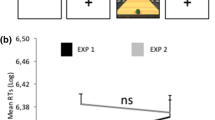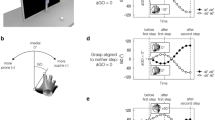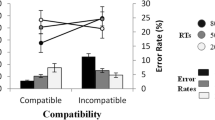Abstract
Action and object are deeply linked to each other. Not only can viewing an object influence an ongoing action, but motor representations of action can also influence visual categorization of objects. It is tempting to assume that this influence is effector-specific. However, there is indirect evidence suggesting that this influence may be related to the action goal and not just to the effector involved in achieving it. This paper aimed, for the first time, to tackle this issue directly. Participants were asked to categorize different objects in terms of the effector (e.g. hand or foot) typically used to act upon them. The task was delivered before and after a training session in which participants were instructed either just to press a pedal with their foot or to perform the same foot action with the goal of guiding an avatar’s hand to grasp a small ball. Results showed that pressing a pedal to grasp a ball influenced how participants correctly identified graspable objects as hand-related ones, making their responses more uncertain than before the training. Just pressing a pedal did not have any similar effect. This is evidence that the influence of action on object categorization can be goal-related rather than effector-specific.


Similar content being viewed by others
References
Ambrosini E, Costantini M (2013) Handles lost in non-reachable space. Exp Brain Res 229:197–202
Ambrosini E, Scorolli C, Borghi AM, Costantini M (2012) Which body for embodied cognition? Affordance and language within actual and perceived reaching space. Conscious Cogn 21:1551–1557
Bach P, Tipper SP (2007) Implicit action encoding influences personal-trait judgments. Cognition 102:151–178
Bach P, Peatfield NA, Tipper SP (2007) Focusing on body sites: the role of spatial attention in action perception. Exp Brain Res 178:509–517
Brass M, Bekkering H, Wohlschläger A, Prinz W (2000) Compatibility between observed and executed finger movements: comparing symbolic, spatial, and imitative cues. Brain Cogn 44:124–143
Briggs GG, Nebes RD (1975) Patterns of hand preference in a student population. Cortex 11:230–238
Buccino G, Riggio L, Melli G, Binkofski F, Gallese V, Rizzolatti G (2005) Listening to action-related sentences modulates the activity of the motor system: a combined TMS and behavioral study. Brain Res Cogn Brain Res 24:355–363
Cardellicchio P, Sinigaglia C, Costantini M (2011) The space of affordances: a TMS study. Neuropsychologia 49:1369
Cardellicchio P, Sinigaglia C, Costantini M (2013) Grasping affordances with the other’s hand: a TMS study. Soc Cogn Affect Neurosci 8:455–459
Catmur C, Walsh V, Heyes C (2007) Sensorimotor learning configures the human mirror system. Curr Biol 17:1527–1531
Catmur C, Walsh V, Heyes C (2009) Associative sequence learning: the role of experience in the development of imitation and the mirror system. Philos Trans R Soc Lond B Biol Sci 364:2369–2380
Cattaneo L, Sandrini M, Schwarzbach J (2010) State-dependent TMS reveals a hierarchical representation of observed acts in the temporal, parietal, and premotor cortices. Cereb Cortex 20:2252–2258
Costantini M, Committeri G, Galati G (2008) Effector- and target-independent representation of observed actions: evidence from incidental repetition priming. Exp Brain Res 188:341–351
Costantini M, Ambrosini E, Tieri G, Sinigaglia C, Committeri G (2010) Where does an object trigger an action? An investigation about affordances in space. Exp Brain Res 207:95
Costantini M, Ambrosini E, Scorolli C, Borghi A (2011a) When objects are close to me: affordances in the peripersonal space. Psychon Bull Rev 18:302–308
Costantini M, Committeri G, Sinigaglia C (2011b) Ready both to your and to my hands: mapping the action space of others. PLoS one 6:e17923
Craighero L, Fadiga L, Umiltà CA, Rizzolatti G (1996) Evidence for visuomotor priming effect. NeuroReport 8:347–349
Craighero L, Fadiga L, Rizzolatti G, Umiltà C (1999) Action for perception: a motor-visual attentional effect. J Exp Psychol Hum Percept Perform 25:1673–1692
Dalla Volta R, Gianelli C, Campione GC, Gentilucci M (2009) Action word understanding and overt motor behavior. Exp Brain Res 196:403–412
De Stefani E, Innocenti A, De Marco D, Busiello M, Ferri F, Costantini M, Gentilucci M (2014) The spatial alignment effect in near and far space: a kinematic study. Exp Brain Res 232:2431–2438
Ferri F, Riggio L, Gallese V, Costantini M (2011) Objects and their nouns in peripersonal space. Neuropsychologia 49:3519–3524
Freeman JB, Ambady N (2010) MouseTracker: software for studying real-time mental processing using a computer mouse-tracking method. Behav Res Methods 42:226–241
Freeman JB, Dale R, Farmer TA (2011) Hand in motion reveals mind in motion. Front Psychol 2:59
Gillmeister H, Catmur C, Liepelt R, Brass M, Heyes C (2008) Experience-based priming of body parts: a study of action imitation. Brain Res 1217:157–170
Hauk O, Johnsrude I, Pulvermüller F (2004) Somatotopic representation of action words in human motor and premotor cortex. Neuron 41:301–307
Helbig HB, Graf M, Kiefer M (2006) The role of action representations in visual object recognition. Exp Brain Res 174:221–228
Jeannerod M, Arbib MA, Rizzolatti G, Sakata H (1995) Grasping objects: the cortical mechanisms of visuomotor transformation. Trends Neurosci 18:314–320
Kiefer M, Sim EJ, Helbig H, Graf M (2011) Tracking the time course of action priming on object recognition: evidence for fast and slow influences of action on perception. J Cogn Neurosci 23:1864–1874
Murata A, Fadiga L, Fogassi L, Gallese V, Raos V, Rizzolatti G (1997) Object representation in the ventral premotor cortex (area F5) of the monkey. J Neurophysiol 78:2226–2230
Pulvermüller F, Shtyrov Y (2006) Language outside the focus of attention: the mismatch negativity as a tool for studying higher cognitive processes. Prog Neurobiol 79:49–71
Pulvermüller F, Harle M, Hummel F (2001) Walking or talking? Behavioral and neurophysiological correlates of action verb processing. Brain Lang 78:143–168
Raos V, Umiltà MA, Murata A, Fogassi L, Gallese V (2006) Functional properties of grasping-related neurons in the ventral premotor area F5 of the macaque monkey. J Neurophysiol 95:709–729
Repetto C, Colombo B, Cipresso P, Riva G (2013) The effects of rTMS over the primary motor cortex: the link between action and language. Neuropsychologia 51:8–13
Rizzolatti G, Sinigaglia C (2010) The functional role of the parieto-frontal mirror circuit: interpretations and misinterpretations. Nat Rev Neurosci 11:264–274
Rizzolatti G, Camarda R, Fogassi L, Gentilucci M, Luppino G, Matelli M (1988) Functional organization of inferior area 6 in the macaque monkey. II. Area F5 and the control of distal movements. Exp Brain Res 71:491–507
Rizzolatti G, Fogassi L, Gallese V (2001) Neurophysiological mechanisms underlying the understanding and imitation of action. Nat Rev Neurosci 2:661–670
Rochat MJ, Caruana F, Jezzini A, Escola L, Intskirveli I, Grammont F, Gallese V, Rizzolatti G, Umiltà MA (2010) Responses of mirror neurons in area F5 to hand and tool grasping observation. Exp Brain Res 204:605–616
Roche JM, Peters B, Dale R (2015) “Your tone says it all”: the processing and interpretation of affective language. Speech Commun 66:47–64
Sato M, Mengarelli M, Riggio L, Gallese V, Buccino G (2008) Task related modulation of the motor system during language processing. Brain Lang 105:83–90
Tettamanti M, Buccino G, Saccuman MC, Gallese V, Danna M, Scifo P, Fazio F, Rizzolatti G, Cappa SF, Perani D (2005) Listening to action-related sentences activates fronto-parietal motor circuits. J Cogn Neurosci 17:273–281
Tucker M, Ellis R (1998) On the relations between seen objects and components of potential actions. J Exp Psychol Hum Percept Perform 24:830–846
Tucker M, Ellis R (2001) The potentiation of grasp types during visual object categorization. Visual Cognition 8:769–800
Tucker M, Ellis R (2004) Action priming by briefly presented objects. Acta Psychol 116:185–203
Umiltà MA, Escola L, Intskirveli I, Grammont F, Rochat M, Caruana F, Jezzini A, Gallese V, Rizzolatti G (2008) When pliers become fingers in the monkey motor system. Proc Natl Acad Sci USA 105:2209–2213
Wiggett AJ, Hudson M, Tipper SP, Downing PE (2011) Learning associations between action and perception: effects of incompatible training on body part and spatial priming. Brain Cogn 76:87–96
Wiggett AJ, Downing PE, Tipper SP (2013) Facilitation and interference in spatial and body reference frames. Exp Brain Res 225:119–131
Author information
Authors and Affiliations
Corresponding authors
Rights and permissions
About this article
Cite this article
Triberti, S., Repetto, C., Costantini, M. et al. Press to grasp: how action dynamics shape object categorization. Exp Brain Res 234, 799–806 (2016). https://doi.org/10.1007/s00221-015-4446-y
Received:
Accepted:
Published:
Issue Date:
DOI: https://doi.org/10.1007/s00221-015-4446-y




